I just love it when I’m at an IEP meeting, feeling really good about a student’s progress. I’m about to share the good news. Jonny is following 2-step directions with 80% accuracy. But wait… The teacher just said he’s not following directions in class?!
Please tell me I’m not the only one?!
To prevent this from happening again, I now check in with my teachers regularly (especially before an IEP). But there’s more to it! This post will cover how to target following directions by:
Get specific: Assess the skills involved in following directions across contexts.
Make it meaningful: Help your student identify reasons why this is a worthwhile skill to work on.
Select visuals & strategies: Decide what supports you’ll use when targeting directions.
Build confidence: Maximize opportunities for structured practice!
Contextualize your intervention: Follow directions using real-life activities.
You’ll notice that last step there: using contextualized, real-life activities! When targeting following directions, it’s important to keep in mind that carryover is the end goal. In an article by Wallach (2014), SLPs are encouraged to identify skills that the student needs to be successful in the classroom — this way, these skills are prioritized during therapy or classroom activities.
“Helping our students with LLD learn how to read and write complex syntactic forms, recognize and use function words and phrases that change meaning (e.g., except for; before/after, etc.), and ask for repetition when needed are representative of more strategic, broader-based targets for processing and comprehending language and for developing advanced syntactic knowledge and skill.”
Now let’s get to it!
Step 1: Get specific!
Assess the student’s ability to follow directions across contexts.
Especially when it comes to following directions, I want to gather some good data on how the student is doing. The student may be struggling for a variety of reasons. To follow directions, a student uses the following skills:
Hearing & vision: Can the student hear the instructions or access instructions in other modality? Is there anything in the environment that is making this more challenging? Example: There’s background noise and Jeremiah misheard the directions.
Executive function: Was the student attending to the instructions? Were there any issues with concentration & working memory? Example: Raquel went to get supplies from the cupboard but struggled to remember what’s needed.
Language comprehension: What was the content of the directions? Did it involve basic concepts, actions, or other vocabulary that are new to the student? Example: “Place your notebook into the clear bin across from my desk.” Christi was confident about the words “notebook” and “desk,” so she held onto her work.
Grammar: Was the student able to understand the structure of the message? Did the message include unfamiliar syntax, such as post noun elaboration, negation, conditions, or out-of-order directions? Example: “If you’ve already finished your work, draw a picture that shows what you did over the weekend.” Alex starts to draw a picture without factoring in the other parts of the sentence.
Other considerations: Is the task appropriately complex for the student’s age or level? Even if the student understands the directions, can they plan, sequence, and complete the task? Is there a reason they are uninterested or unwilling to participate? Example: When PE is wrapping up, Sean doesn’t put away his equipment and line up when asked. Does Sean take more time to transition? Is he wanting to keep playing?
Check out the leveled assessments (included in the SLP Now membership) to assess where a student is having the most difficulty. What patterns are present and which kind of support is needed for the student to be successful?
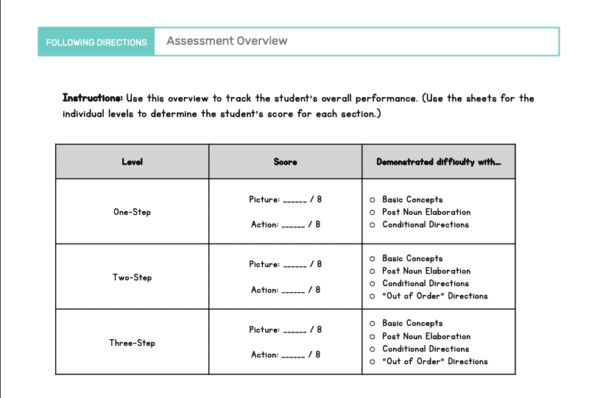
I also observe in the classroom. *This is often more helpful and meaningful than any paper assessment!* I use the data to identify areas for intervention and strategies for the student, for the teacher, and for myself.
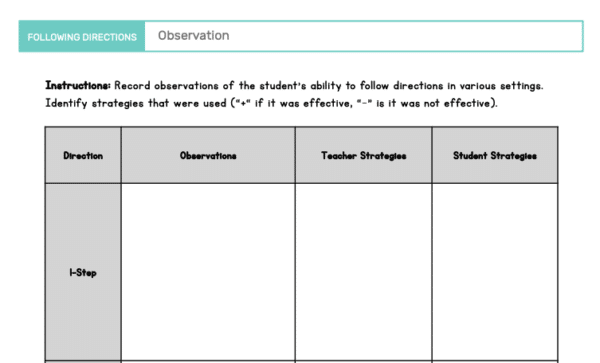
Step 2: Make it meaningful!
Discuss why it’s important to follow directions.
We always start off with a quick introduction of the skill. I pull out the visuals (see examples below) and verbally walk through them with the student. I’ll make note of which directions they’ve mastered and which directions we’ll continue to target in therapy (based on the quick assessment and the observation).
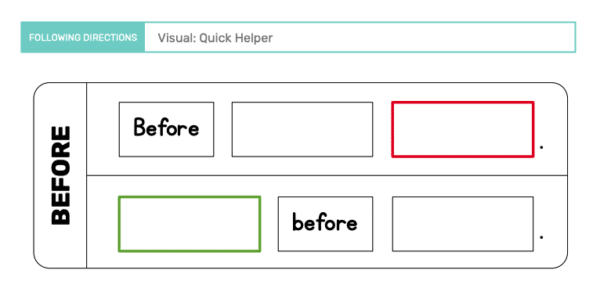
When I teach a skill — especially with older students — we talk about why we want to target this skill. Ideally, they’d also be involved in the process of selecting goals in the first place.
Here are some reasons why students might care about following directions:
Home life: To avoid nagging from family members. (Taking out the garbage right away works out better for everyone, anyways.)
Social life: To make plans with friends. (Before we go to the movies, we’ll meet at Joey’s at 3:15.)
Hobbies: To learn how to play new games. (They need to follow directions to understand the rules!)
School: To know what’s happening in class. (Because let’s be honest — it’s a good feeling to know what you’re doing rather than feeling lost!)
An article by Washington (2007) highlights the importance of embedding the ICF Framework into our practice with students. Think about all the participation restrictions involved if we’re unable to follow directions — then center your treatment around the things that help your students access their educational environment and feel successful!
Step 3: Select visuals & strategies.
Decide what supports you’ll use when targeting directions.
If I find that students are struggling with directions due to a lack of basic concepts or vocabulary, then I’ll target those skills first. ***More on those basic concepts and vocabulary in future posts!
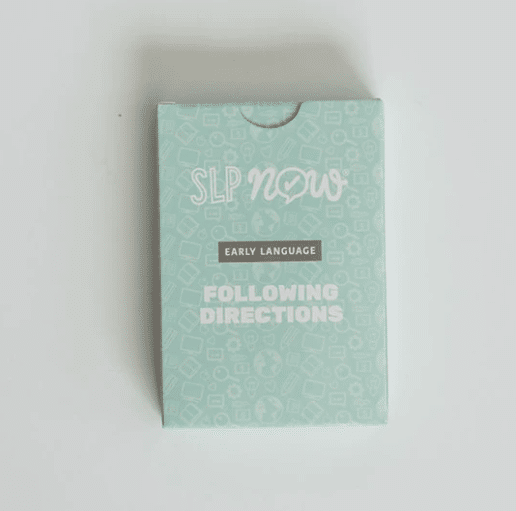
If the student really has a hard time following directions (e.g., holding on to the information, understanding the syntax, etc.), then I’ll use my Following Directions pack.
Starting Out: To build some momentum, I often use the routine direction cards (e.g., brush your teeth, go to bed, eat dinner, etc.) for some errorless learning. Bonus points for functional activities of daily living!
Incorporating Visuals: Introduce sorting mats to show how some directions follow the rules (“regular”), while others are reversed (“out of order”) or conditional (“depends on something”). I will use direction cards by reading the direction (“Dance after you laugh.”), do some meta talk (“This is one of our reverse directions! I need to move the cards.”), move the cards in the correct order, and then follow the direction (laugh, then dance). I often have students pick some of the direction cards to increase engagement. (They love telling me what to do!)
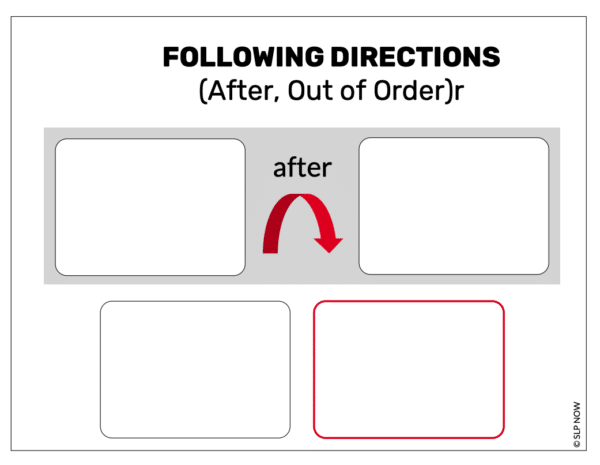
Using Strategies: Although these mats are very helpful to build “component skills”, the heart of treating following directions is STRATEGIES! A study by Gill et al. (2003) showed that elementary students using rehearsal/visualization strategies made significant gains when tested on their ability to follow directions, as compared to a traditional language therapy group. We want to help our students follow directions with greater ease from the get-go.
Strategy Handout for Teachers (part of the SLP Now membership): I’ll review my observations with the teacher and together, we’ll determine what we can do to support the student’s ability to follow directions across settings.
Strategy Handout for Students (also from the membership site): Now it’s their turn! We review some of the strategies and pick one or two to focus on. We may tape a strategy card (or another visual created by the student) to the student’s desk.
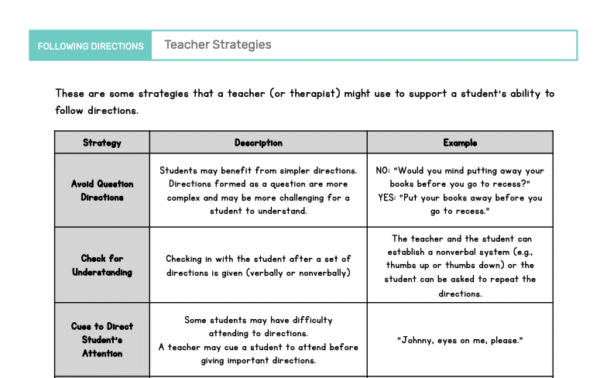

Step 4: Build confidence.
Maximize opportunities for structured practice!
Now that your student is equipped with visuals, strategies, and support, dive in! Instead of the SLP modeling, the student will have an opportunity to practice. Here are some ideas:
Take turns giving and following directions. There is one thing that students love more than telling me what to do: they love telling me that I’m wrong. I let them be the therapist and correct me if I don’t follow the directions.
Have students write/draw the direction on the visuals. By mapping out the steps involved, it can help things click! (Plus you get lots of interesting pictures.)
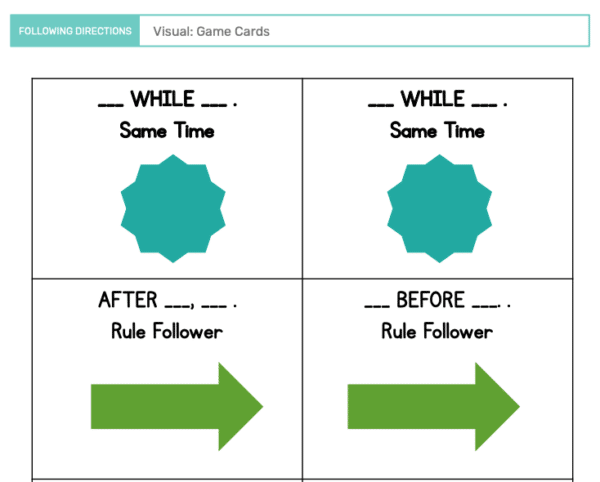
Use preferred hobbies and games. Does your student like coloring or have a favorite Disney character? Target relevant directions using these printable coloring pages! How about a student that loves Toca Boca apps, Jenga, playing with felt food, or legos? Check out this post[LINK] with a list of language-stimulating apps that can be used for following directions.
Build-in movement breaks. Maybe you already use these in therapy! Now you can get more bang for your buck by targeting directions. Some ideas include hopscotch, balloons/bubbles, Simon Says, twister, & Go Noodle!
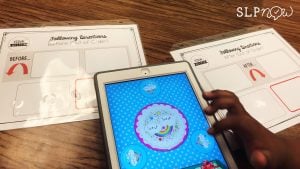
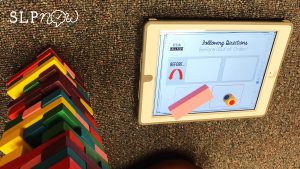

Step 5: Contextualize your intervention!
Follow directions using real-life activities.
When transitioning from structured therapy tasks to everyday activities, you can continue using the sorting mats to support carryover. Instead of using the direction cards, however, you can draw quick pictures (if visuals are needed).
Here are some ideas of functional activities to support in the classroom or around school:
Arts & Crafts: These activities are packed with directions, including setting up, sequencing steps, and cleaning up. For a variety of themed and literacy-based units, the SLP Now membership has craft templates with photos for each step. They pair well with the sorting mats!
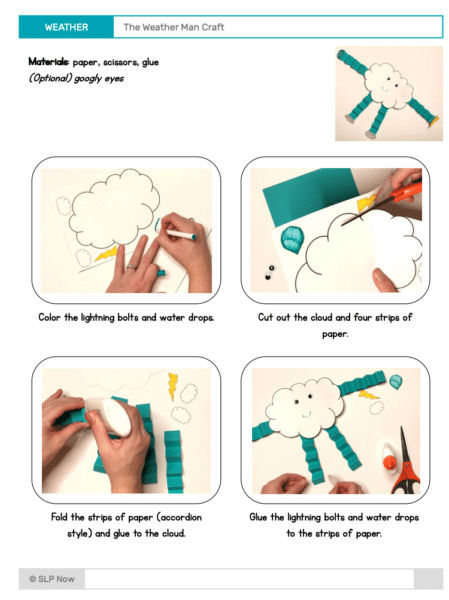
PE & Recess: Consider what motor-based activities take place during your student’s day: games or sports on the playground, freeze dance, completing an obstacle course or fun run, jump rope, scavenger hunts — you name it!
If your student also receives occupational or physical therapy, look into co-treating.
Curriculum: One option is to use a curriculum-based activity in therapy (e.g., a book report). We can help students follow directions in our therapy room, but we’ve had the most success teaching strategies and then supporting this skill in the classroom. This is especially true if the student is struggling with directions (not a lack of vocabulary).
If that’s not possible, I’ll use directions similar to what the teacher gave in the classroom during my observation. Sometimes teachers are also able to come up with examples, and I’ll use those. I always try to embed some direction within our activities as well (e.g., “Before you turn the page, go get a pink and yellow highlighter.”).
What other parts of the school day could be used to support carryover?
I hope this was helpful! Comment below with your favorite strategies or any questions that you might have!




I wish this was available when I was in grad school many years ago, I think the strategies are the most important to talk about (go meta) and acquire yet were rarely discussed in the what (what strategies in which language areas) and the how (how to teach them). Thank you so much for clearly providing the framework that is much needed for those who are very much used to the ‘worksheet’ mode of teaching speech and language.
Thank you so much for that feedback, Agnes! So glad this was helpful!
Where can I find these sheets? I would love to use them in therapy 🙂 exactly what I was about to create!
Hi Katy! The sheets are included in the SLP Now Membership! slpnow.com
Great suggestions. This has long been a challenge of mine, and close collaboration with the teacher is a perfect idea, as well as the visuals.
I’ve also been making “help” cards with a few students recently, which goes along with your Strategies, above. If they’re able, students can come up with some of the self-advocacy phrases, so they have more buy-in. Then we color-code the cards (only 3-4 different cards per student), and keep one set in Speech, one in each classroom, and one spare, if possible.
Awesome blog post! Thank you!
Your visuals are always my “why didn’t I think of that” moment – so thank you! What do you do for those kiddos who have difficultly with direction following but also have impacting attention difficulties? After providing accommodations in the classroom and with good success in a structured environment with directions – where do you go next? I tend to drop the following directions goals and continue to work on listening strategies (not in a goal, just for practice) – am I missing a step?
Great question! I do work on strategies with those students. (The following directions pack includes some strategies visuals.) That said, there’s definitely more to it than that. 🙂
There’s a presentation at the SLP Summit on attention that would be a great start! slpsummit.com
I also love Sarah Ward’s work in that area!
Hi, Marisha. Are these direction-following sheets still included in the membership?
Thanks-
Jen
Yes!
Hello Marisha!
Just curious if there was a specific title to the “future” post about vocabulary/basic concept teaching if FD may not be the first place to start with a kiddo.
Thank you !
Here you are! https://blog.slpnow.com/009-how-to-target-basic-concepts-in-speech-therapy/